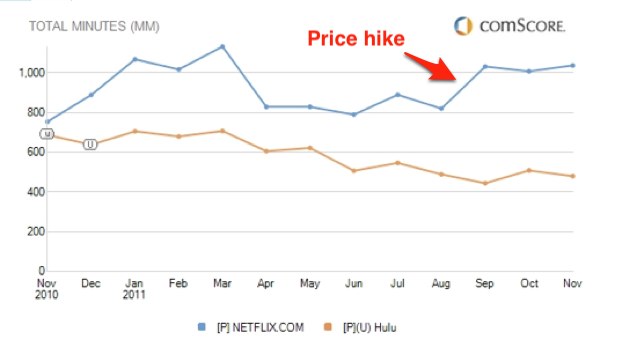Netflix and Hulu are the two leading video streaming services on the Web when it comes to mainstream TV shows and movies. More people watch Netflix online than Hulu, and have since about 18 months ago. In November, 2011, comScore estimates that Netflix.com attracted 26.6 million unique visitors, versus 20.2 million for Hulu
But a better metric to compare the two is how much time people actually spend at each site. And there Netflix trounces Hulu by two to one. U.S. visitors spent 1 billion minutes on Netflix.com in November, 2011, versus 480 million minutes on Hulu, according to comScore. (One caveat here is that people also go to Netflix.com to manage their DVD accounts and browse movie titles in addition to streaming videos, but the growth in time spent is most likely coming from streaming). Netflix has an edge over Hulu in that it streams more movies than TV shows, and those tend to be longer. But if that was the only factor, you’d expect to see the same ratio over time. Yet back in November, 2010, the two services were almost neck-and-neck in time spent, with Netflix users logging 750 million total minutes versus Hulu users logging 690 million.
A few things happened over the past year which explain this growing gap. One is that Hulu, which started as a free, ad-supported video service, shifted strategies and pushed harder to convert viewers to paying subscribers. As a result, the number of people going to Hulu every month stopped growing (its 20 million unique U.S. visitors in November, 2011 was down from 21 million the year before). Netflix, on the other hand, spent the year promoting its streaming service at the expense of its DVD rental business (its U.S. unique visitors increased by about 8 million people over the same time period). Another difference is that Netflix benefits from the fact that it already has a paying subscription relationship with all of its customers, whereas Hulu still has a mix between free and paying viewers.
The biggest jump in time spent on Netflix, however, occurred in September, 2011, when it rose by 26 percent in a single month (from 820 million minutes to 1.03 billion). September was the month when Netflix’s price hikes went into effect for subscribers who chose to keep both streaming and DVD rentals. For all the subsequent damage to Netflix’s brand and stock, the move did seemingly have the desired effect of boosting viewership of the streaming service.
The total time spent on Netflix has been flat the three months since the big change. Now it needs to prove that streaming is indeed a better model than DVDs, and that should be reflected in subscribers spending even more time on Netflix. Time spent on Hulu should increase also as streaming becomes part of people’s regular viewing habits.
The biggest barrier here remains the living room TV. For the vast majority of viewers, it’s still not hooked up to the either service. But once you do connect a big screen to the Internet, Netflix and Hulu become a lot more compelling. In my house, for instance, we are still only occasional viewers. We watch Hulu on a laptop in the kitchen or in my home office where I have a large screen already connected to my computer. My wife and I watched a movie on Netflix last night. We could have watched it on the bigger screen in the living room, but that would have entailed pulling out an HDMI cable and plugging in a laptop. The path of least resistance was the office set-up.
My New Year’s resolution will be to hook up the living room TV to the Internet. Once I do that, I am sure we will be watching a lot more Netflix and Hulu. I don’t think we will be alone.
